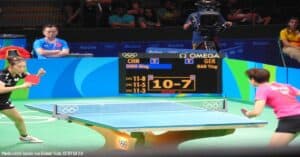Spin has a major impact on any ball sport, be it in table tennis, tennis, football, or cricket. It is the spin that creates doubt in your opponent’s mind and helps you dominate the game. Before going into details about spin in table tennis, let’s see what spin is.
What is a Spin in Table Tennis?
Spin is the angular momentum that is imparted to a ball. When you spin a ball, it behaves differently with the air than a ball without spin.
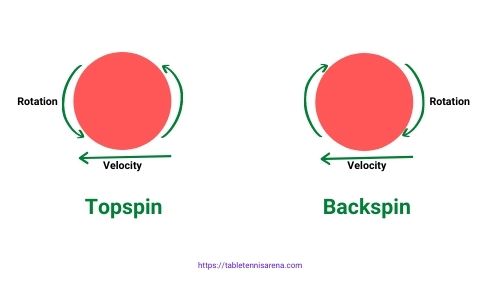
If you brush the ball tangentially at the top, it rotates in the direction of the ball and dips. It is the topspin that you can create by the swing of the racket in the direction of the ball.
In opposite, if you brush the ball tangentially at the bottom, it rotates in the opposite direction of the ball and floats in the air. It is the underspin that you can create by slicing the ball.
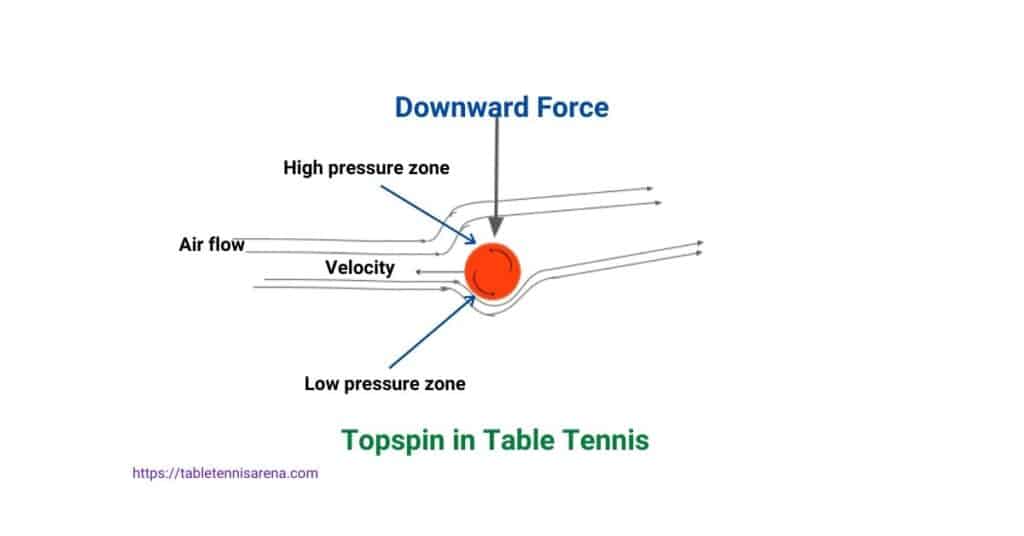
When the ball rotates against the direction of the flow of air, the top surface collides with the air, which in turn creates a high-pressure zone. The bottom surface traveling in the same direction of airflow helps the air accelerate and creates a low-pressure zone.
So, due to the pressure difference, there is a downward force on the ball. In this case, the ball dips and travels less than a non-spinning ball.
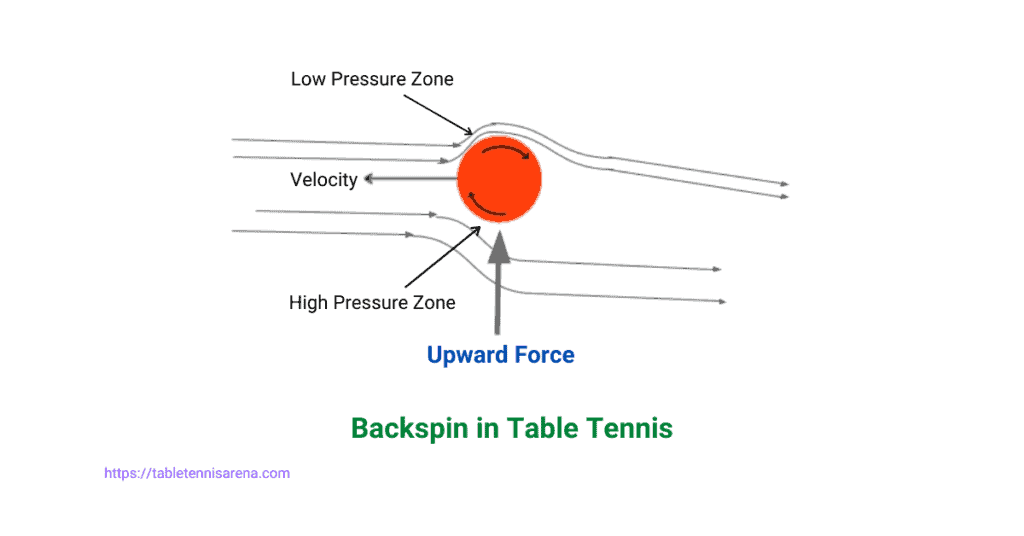
In opposite, when the ball rotates in the direction of air, there is an upward force that causes the ball to deviate upwards to the low-pressure area.
This phenomenon is known as the Magnus Effect.
What are the Types of Spin in Table Tennis?
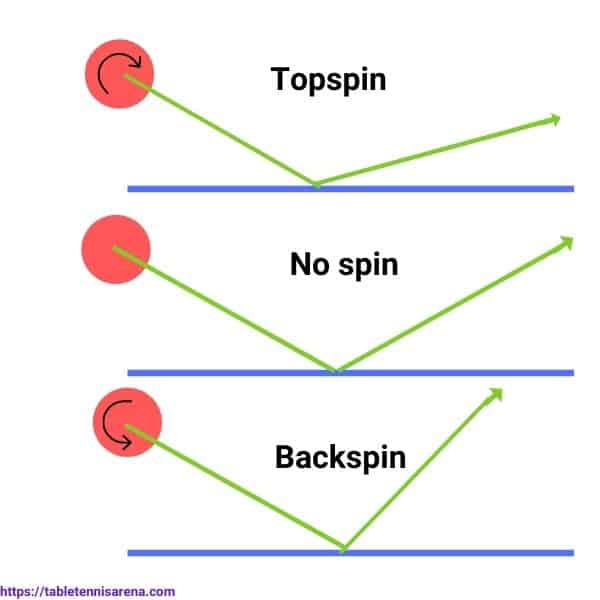
There are four types of spin in table tennis.
- Topspin: By brushing at the top of the ball
- Backspin: Brushing action will be at the bottom of the ball
- Sidespin: By brushing at either side of the ball
- No-spin: By hitting the ball with your racket at an angle of 90 degrees to the equator of the ball
Let’s come to the details of each type of spin in table tennis.
Topspin
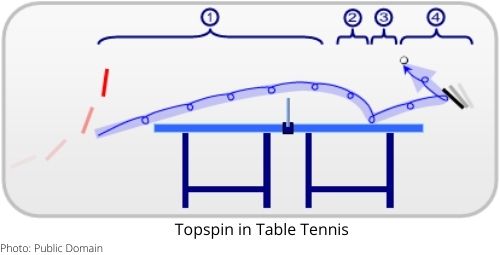
As I have discussed earlier, in this type of spin, the table tennis ball dips due to the downward force and follows a lower trajectory than a non-spinning ball.
To create a topspin, you have to brush tangentially on the top of the ball. The movement of the racket will be from low to high.
After hitting the table, the bottom surface of the ball tends to slide backward. The frictional force will act in the opposite direction to this motion as a forwarding motion. This will result in the ball moving faster at a low angle after hitting the table.
Backspin
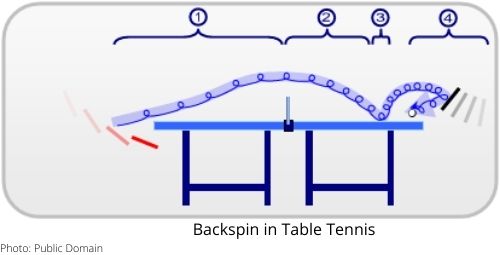
This is just opposite to topspin and due to the upward force, the ball floats at a slower speed at a higher trajectory.
To create a backspin, your brushing action will be at the bottom of the ball and your bat will move from high to low.
After hitting the table, the bottom surface tends to slide forward. This will result in the frictional force acting as a backward force and it will drag the ball towards the net at a slower speed and a higher angle.
Sidespin
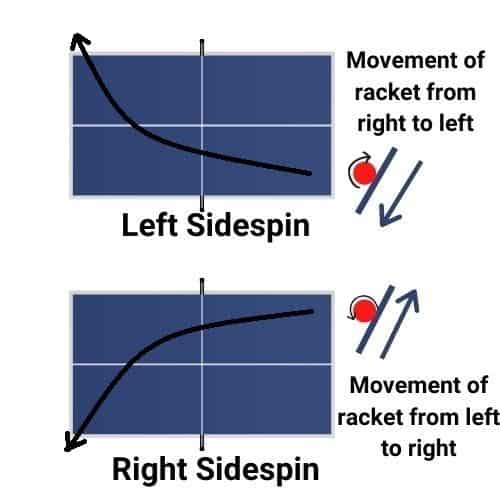
To create this spin, you have to brush on the side of the ball. If you move your racket from right to left and brush the ball on the left side, it will create Left Sidespin which will move the ball in the right direction.
In opposite, when you move the racket from left to right to brush the ball on the right side, it will create the right sidespin which will move the ball in the left direction.
No-spin
If you hit the ball with your racket at an angle of 90 degrees to the equator of the ball, there is no angular momentum imparted to the ball. This is no-spin and after hitting, the ball will move forward without any spin.
Players use no spin as a surprise element during service. When your opponent is highly expecting a spinning serve, a no-spin serve can disguise him easily.
How to Create Spin in Table Tennis?
To create spin, you have to impart angular momentum by brushing the ball tangentially. When you brush at the top of the ball to create Topspin, you can brush at the bottom to create Backspin and at the side for Sidespin.
But how to generate maximum spin?
It’s simple. Only by giving more rotational speed to the ball. The ball, that rotates more, spins more. Now how can we give more rotational speed to the ball?
That can be done by faster racket movement. The faster the racket brushes the ball, the more the ball rotates and invariably it spins more.
Now how can we generate faster racket movement?
- Faster arm speed: This again depends on the movements of several body parts like the knee, hip, shoulder, and leg.
- Faster wrist action: By wrist action, I mean flicking your wrist with a fast snapping motion. Your wrist should be flexible, not in locked condition.
- Brushing the ball at the top edge of the racket: The top edge of the racket can give the ball more rotational speed than the rest part of the bat which will increase the spin.
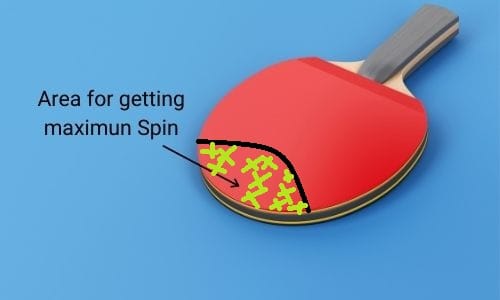
How to Read Spin in Table Tennis?
There are several ways that you can read the spin.
- Simply by watching the racket angle
- By seeing the flight trajectory of the ball
- By watching the logo of the ball
- Listen to the sound carefully
Simply by watching the racket angle: If the racket has a downward to upward movement, it is generating topspin, and the ball dips with a fast and shorter trajectory.
On the opposite, if the racket has an upward to downward movement, it generates a backspin and it will drag the ball towards the net at a slower speed.
If the racket moves from right to left, it is left sidespin, and the ball moves on the right side.
If the racket moves from left to right, it is right sidespin and the ball moves on the left side.
By seeing the flight trajectory of the ball: Different spins have different flight trajectories. And seeing the trajectory of the ball, you can easily guess the types of spin.
By watching the logo of the ball: If you can see the logo of the ball, then there is no spin or little spin. But if the logo is not visible to you, that means the ball is rotating faster and as a result, it has a lot of spins.
Listen to the sound carefully: As you advance in your level of play, you will be able to differentiate between heavy spin and no spin by listening to the sound. A flatter and harder sound means no or little spin whereas a softer and brushing sound indicates heavy spin.
How to Play Against Spin in Table Tennis?
To play against spin, you have to first read the type and amount of spin in the ball.
How to Play Against Backspin?
If your opponent is generating underspin or backspin, it may be a short ball or a long ball.
For the short ball, there are two common ways to return the ball, one is pushing and the other one is the flick.
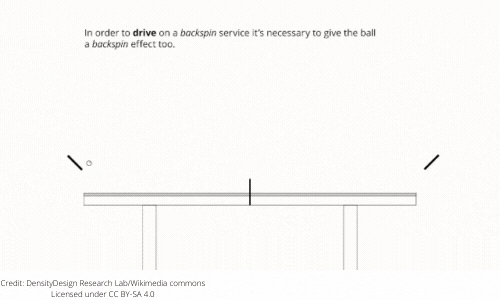
When you are pushing the ball, you have to open the angle of the bat, otherwise, you will not be able to bounce the ball on the other side of the table over the net.
To flick a short underspin ball, come close to the ball and lift the ball over the net. Your racket angle should be open at the start to counter the backspin and forwards with a closed bat angle.
For a long underspin ball, if you are a defensive player, you may produce a long push with an open bat angle or you may go for a chop shot.
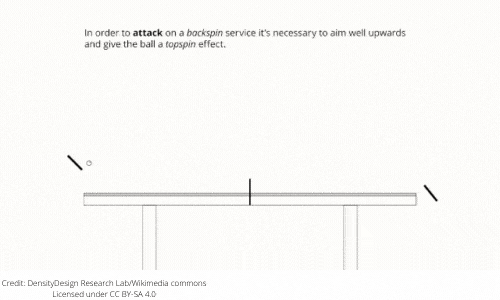
To attack an underspin ball, your best option is to go for a topspin shot, it may be a forehand topspin or backhand topspin.
How to Play Against Topspin?
If you are facing a short topspin shot, there are three ways to play it. You can block it with a closed racket angle and your bat facing towards where you want to return. The racket angle depends on the amount of topspin that you receive. You can also punch the ball at the top of the bounce or you can make a counter topspin shot.
For a long topspin shot, there are two common practices to counter it. If you are an attacking player, the best way to go for it is with a counter-topspin. For defense, you may slice the ball with a lot of underspin.
How to Play Against Sidespin?
For sidespin, understanding the type of sidespin is the main factor. Is it the right sidespin or the left sidespin? The angle of your racket should be in the opposite direction of the ball. Watch the starting position of your opponent’s racket and angle your racket in that direction to return the ball.
Let’s illustrate this with an example. Suppose, your opponent is a right-hander and he is doing a pendulum serve which is a left sidespin serve. To create this left sidespin, his bat is moving right to left which is from his forehand side to his backhand side. The left sidespin will drift the ball in your left direction.
To counter this left sidespin, you have to direct your racket to the right-hand side which is the forehand side of your opponent. Note that, it is the starting position of your opponent’s serve.
On the opposite, if he imparts a right sidespin serve, his bat will move from left to right. then face your bat toward the left-hand side of your opponent which is the backhand side of your right-handed opponent.
Tip: If you are unable to understand the type of sidespin, aim to place the ball in the middle of the table. On most occasions, the ball will land on the table.
Conclusion
Understanding the spin is a must to begin your journey in table tennis. As you go deep into it and experiment with your game, you can develop new techniques. But to be precise and master your technique, you need practice and discipline. And if you have passion and dedication, then nothing can stop you from becoming a successful table tennis player.
